Digital Poster
Mesocale fMRI
ISMRM & ISMRT Annual Meeting & Exhibition • 10-15 May 2025 • Honolulu, Hawai'i

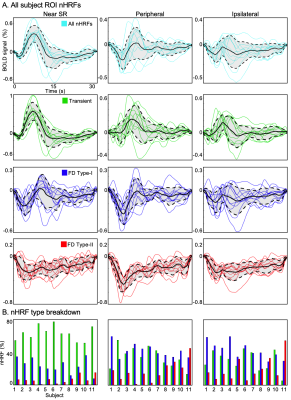 |
Computer Number: 65
2325. Spatiotemporal
variation of the negative hemodynamic response function along
the cortical surface of the primary visual cortex in human brain
A. Vinogradov, N. J. Fesharaki, M. Jung, J. Kim
UTHealth Houston, Houston, United States
Impact: An evolution of nHRF dynamics is apparent with
distance from the SR. Different types of nHRFs are found,
indicating more complex dynamics of the nHRF.
|
|
 |
Computer Number: 66
2326. Effect
of thermal and physiological denoising on laminar functional
connectivity
M. Guidi, G. Giulietti, D. Sharoh, H. Möller, D. Norris, F.
Giove
INFN-LNS, Catania, Italy
Impact: High-resolution BOLD-fMRI data can provide
information on laminar functional connectivity (FC), but
physiological and thermal noise could strongly degrade
signal quality and bias results. This study quantifies the
impact of different denoising strategies in the estimation
of laminar FC strength.
|
|
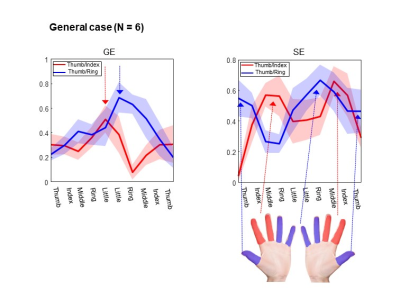 |
Computer Number: 67
2327. 7T
Spin-echo functional MRI reveals mirrored representations in the
human motor cortex
S. Han, S. Eun, D. Kim, H. Cho, S-G Kim
Korea Basic Science Institute (KBSI), Ochang, Korea, Republic of
Impact: By facilitating real-time assessment of
individual performance and utilizing motor behavioral data,
this approach will improve the quality of fMRI data analysis
and may support a diverse range of experimental paradigms.
|
|
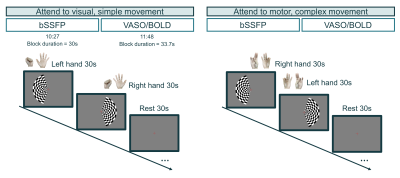 |
Computer Number: 68
2328. CAIPI
accelerated 3D bSSFP for laminar fMRI at 7T
Z. Zhang, Y. Wang, C. Liu, Q. Zhang, J. An, C. Qian, P.
Zhang, Z. Zhang
State Key Laboratory of Brain and Cognitive Science, Institute of Biophysics, Chinese Academy of Sciences, Beijing, China
Impact: This study integrates 3D bSSFP acquisition into
task-based fMRI, employing 2D-CAIPI acceleration to enhance
acquisition speed, and conducts a comparative analysis with
BOLD fMRI, highlighting the superior spatial localization
accuracy of bSSFP.
|
|
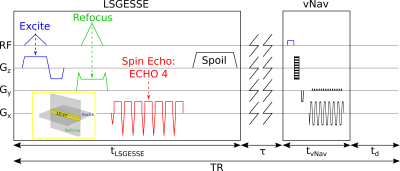 |
Computer Number: 69
2329. Combined
prospective and retrospective motion correction for
high-resolution linescan acquisitions in the human cerebral
cortex at 7T
M. Balasubramanian, J. Polimeni, D. Tisdall, A. van der
Kouwe, R. Frost
Harvard Medical School, Boston, United States
Impact: Motion-robust linescan techniques will help
enable the measurement of tissue microstructure and
microvascular fMRI signals at high spatial resolutions,
approaching the thickness of individual cortical layers,
facilitating noninvasive studies of cortical circuitry and
architectonics in the living human brain.
|
|
 |
Computer Number: 70
2330. FMRI
using 1D “linescan” and 2D imaging are also often equally
sensitive: comparing SNR efficiency in theory and practice
N. Yusif Rodriguez, M. Cloos, M. Balasubramanian, X. Yu, J.
Polimeni
Massachusetts General Hospital, Charlestown, United States
Impact:
We address concerns that 1D linescan for BOLD-fMRI has limited SNR compared to equivalent 2D scans. Our results show comparable SNR efficiencies between these two methods, highlighting the benefits of 1D linescan for future studies of human cerebral cortical layers. |
|
 |
Computer Number: 71
2331. Comparison
of Layer-Specific BOLD Responses Across Cortical Depths Using 7T
Line-Scanning fMRI
G. Liu, T. Ueguchi, S. Ogawa
CiNet, NICT, Osaka, Japan
Impact: The
percentage change of BOLD response depends greatly on both
depth from the pial surface and TE. 1D line-scanning can
play a crucial role in advancing mesoscopic fMRI resolution
(e.g., layer-specific fMRI), potentially surpassing the
conventional resolution of 0.8 mm
|
|
 |
Computer Number: 72
2332. Cortical
layer-dependent response changes in M1 in Parkinson's Disease: a
submillimeter 7T fMRI study with 3D passband balanced SSFP
Y. Wang, D. Su, R. Yan, L. Knudsen, N. Wei, J. An, T. Feng,
P. Zhang
State Key Laboratory of Brain and Cognitive Science, Institute of Biophysics, Chinese Academy of Sciences, BeiJing, China
Impact: These findings provide clues to to dysfunctions
and progression of PD in the M1 microcircuitry, showscasing
that laminar fMRI is a valuable tool for investigating the
mechanisms underlying neurodegenerative disorders.
|
|
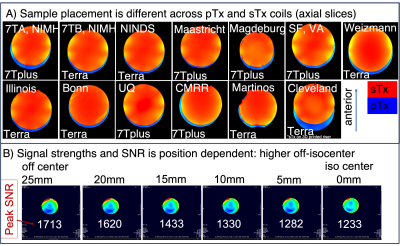 |
Computer Number: 73
2333. Should
I do 7T fMRI with the pTx or sTx coil? Consider the difference
in geometry
R. Huber, A. T. Morgan, A. Pizzuti, B. Poser, B. Dymerska,
D. Bosch, Y. Chai, N. Gudino, J. Sarlls, S. Dresbach, A. T.
Vu, J. Evans, S. Torrisi, R. Stirnberg, M. Tourell, S.
Bollmann, L. Vizioli, E. Yacoub, N. Priovoulos, E. Brouwer,
W. van der Zwaag, H. Mattern, D. Gomez, A. Blazejewska, J.
Polimeni, P. Bandettini
NIH, Bethesda, United States
Impact: Geometrical design choices play a surprisingly
large role for 7T fMRI when choosing the optimal coil.
|
|
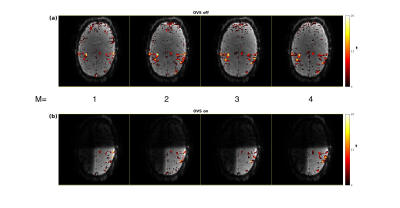 |
Computer Number: 74
2334. Investigating
the Impact of Spatially Selective Signal Suppression on BOLD
fMRI Reliability
Y. He, L. Hernandez-Garcia, D. Noll, J-F Nielsen
University of Michigan, Ann Arbor, United States
Impact: Outer-volume suppressed fMRI can produce
reliable activation maps, and may be a promising candidate
for high-resolution (e.g., layer-specific) fMRI.
|
|
 |
Computer Number: 75
2335. Crossing
the scales: Opto-magnetic imaging can reveal cortical
propagation of circuit-dominating slow wave events
D. Cleppien, M. Schwalm, H. Backhaus, T. Fu, F. Aedo-Jury,
G. Schneider, A. Stroh
Leibniz Institute for Resilience Research, Mainz, Germany
Impact: This study bridges concepts and methods spanning
from optical imaging of local microcircuits to optic-fiber
photometry and fast fMRI to follow a defined
neurophysiological event, the slow wave event, across the
scales, from single cells to non-invasive cortex wide fMRI.
|
|
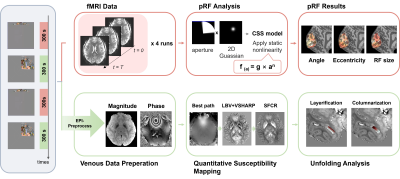 |
Computer Number: 76
2336. Investigating
Venous Interference in Population Receptive Field Estimation
using High-resolution 3D-EPI at 7T
Y. Yang, C. Qian, H. Zhang, J. An, S. Li, R. Xue, Z. Zhang
State Key Laboratory of Brain and Cognitive Science, Institute of Biophysics, Chinese Academy of Sciences, Beijing, China
Impact: This study provides new insights into the role
of venous interference in pRF estimation, with the potential
to address longstanding challenges in understanding the
venous structure of visual cortex and improving the accuracy
of retinotopic mapping.
|
|
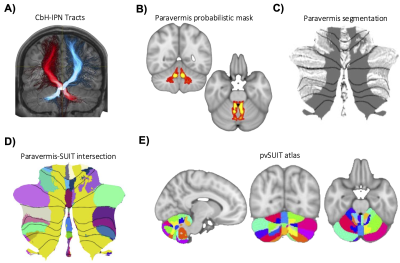 |
Computer Number: 77
2337. Mesoscale
functional characterization of cerebellar stripes lays the
foundation for linking molecular specificity to fMRI signals
R. Lorenzi, S. Tartabini, A. Geminiani, C. Gandini Wheeler
Kingshott, C. Casellato, E. D'Angelo, F. Palesi
Università di Pavia, Pavia, Italy
Impact:
We introduced zebrin-specificity into the cerebellar mean-field model and mapped it onto a new cerebellar high-resolution parcellation for large-scale signal modeling. This opens the possibility to refine an observational model to retain this molecular differentiation in fMRI signal simulation. |
|
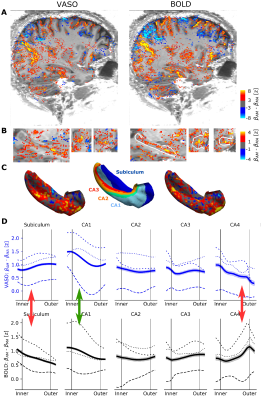 |
Computer Number: 78
2338. Functional
imaging of hippocampal layers using VASO on the Next Generation
(NexGen) 7T
S. Häkkinen, A. Beckett, E. Walker, R. Huber, D. Feinberg
Helen Wills Neuroscience Institute, Berkeley, United States
Impact: Hippocampal fMRI using VASO contrast allows
mapping layer function with high accuracy, made possible by
optimization for the NexGen 7T scanner. Spatial accuracy and
venous biases are a central concern for studies developing
mechanistic models for hippocampal circuits.
|
|
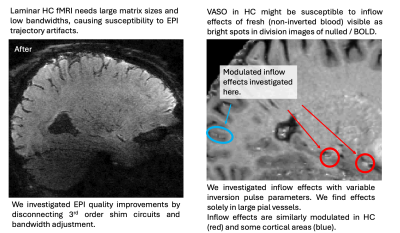 |
Computer Number: 79
2339. Blood
volume sensitive laminar fMRI with VASO in human hippocampus:
Capabilities of clinical 7T and biophysical challenges
K. Ahmadi, S. Swegle, M. Rubin, A. T. Morgan, A. Bouyeure,
P. Bandettini, N. Axmacher, R. Huber
Ruhr University Bochum, Bochum, Germany
Impact: Our preliminary results indicate that mesoscale
VASO collected using conventional 7T scanners can capture
functional activity changes in hippocampus, providing a
groundwork for future investigations of underlying neuronal
circuitry of higher-order cognitive functions and their
alterations in neurodegeneration.
|
|
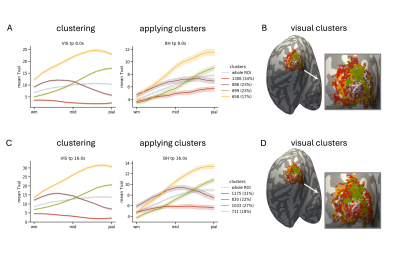 |
Computer Number: 80
2340. Spatial
heterogeneity of cerebral cortical-depth response profiles in
gradient-echo BOLD fMRI: neuronal or vascular origins?
A. Arsenovic, J. Polimeni, A. Blazejewska
Athinoula A. Martinos Center for Biomedical Imaging, Massachusetts General Hospital, Charlestown, United States
Impact: Comparison of cortical-depth profiles in
visual-task and breath-hold task induced BOLD fMRI responses
revealed an interplay of vascular and neuronal components,
which could be exploited to develop novel data-driven
approaches for vascular bias mitigation and improved
neuronal specificity.
|
The International Society for Magnetic Resonance in Medicine is accredited by the Accreditation Council for Continuing Medical Education to provide continuing medical education for physicians.